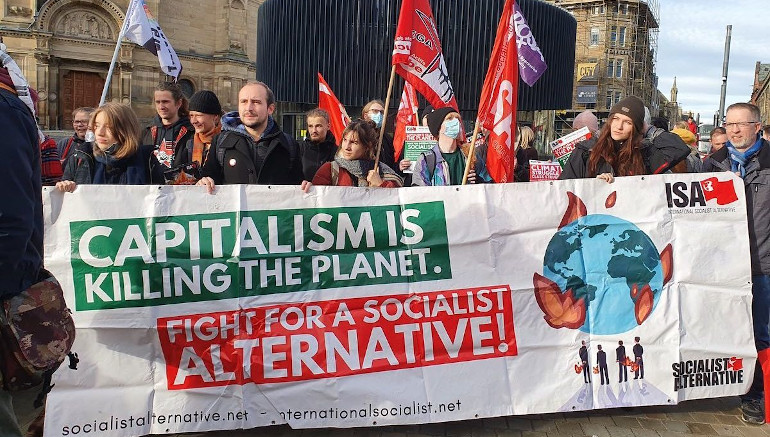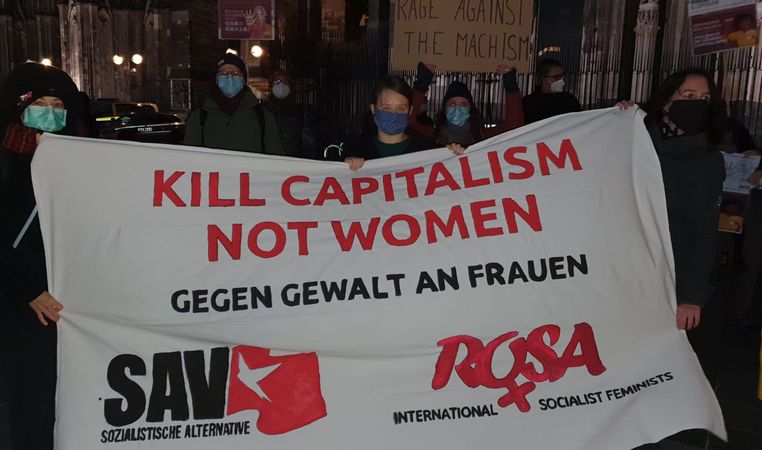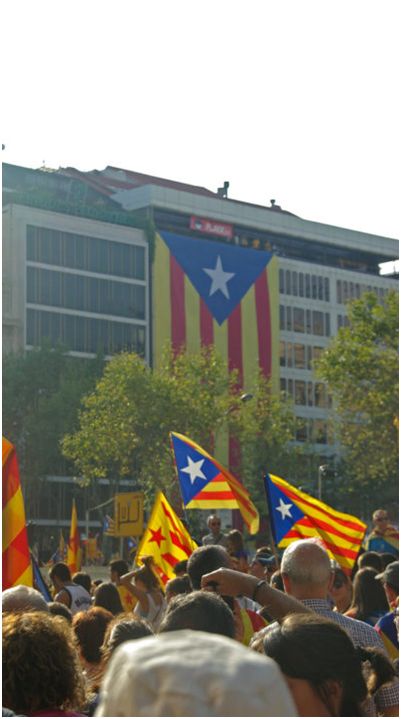Philip Chmel is a member of Linkse Socialistiche Partij / Parti Socialiste de Lutte (ISA in Belgium).
The unfolding climate crisis is the clearest sign, among many, that this system has to go. “The World Meteorological Organization reported recently that the climate crisis has spawned extreme weather that has killed more than 2 million people over the last 50 years, with over $3.6 trillion in economic damage. Researchers found a fivefold increase in the number of extreme weather events compared to 1970.” (Democracy Now on Thursday 02/09/2020)
This statement reaffirms the sensation that we see, hear, read and experience in our daily lives more and more frequently: The situation is dire and it will get worse. The climate crisis has been unfolding for years. It is picking up speed, will inevitably cause unprecedented destruction in our lifetime and lead to even more severe climate catastrophes if we do not radically change its course during the 2020s. Under capitalism, nightmare scenarios with increased emissions leading to a 3 – 5 degrees increase in the global average temperature and raising sea levels by several meters, are almost guaranteed. This means the conversion of large parts of our planet into areas not compatible with human civilization.
There is Still Hope
However, there is also hope: According to the 2021 IPCC report, global heating can be limited if greenhouse gas emissions are reduced at necessary speed and scale. But in order for this to be possible, we need revolutionary system change. While this is undoubtedly a major challenge, solving the climate crisis within the limits of capitalism is straight out impossible.
Capitalist governments and institutions, increasingly aware that they have to at least be seen to try to do something big (and make some big bucks in the process) will undoubtedly bend to pressure and implement new policies, including big state intervention similar to that seen during the pandemic. But it will all quite simply not be big enough, or fast enough, to get the change we need in the 2020s.
The laws of endless capital accumulation and competition, together with national division and antagonism, are part of the system’s DNA, they are not up for debate and the ruling classes don’t shy away from enforcing them with violence if need be. These contradictions of capitalism stand like giant walls in the way of progress to save the climate.
There is no way around it, if we want to save humanity from barbarism and climate catastrophe, we need to replace the destructive capitalist system with a democratically socialist system in which production, distribution and the whole of the economy are planned based on the needs of people and the environment under democratic control and government from below.
A Class Issue
People are obviously not equally affected by the effects of the climate crisis: The rich can afford private generators to secure their power supply, properly insulate their houses against heat and cold or move away from areas particularly affected by extreme weather events. The super-rich even have their private bunkers in New Zealand to try to escape the climate apocalypse.
The working class and poor on the other hand, do not have those choices. Instead, working people (especially those who are people of colour, women and marginalized groups) are affected disproportionately by the climate crisis, despite contributing only a fraction of global greenhouse gas emissions. However, on the plus side, it is also these same people — the global working class and oppressed — that have both the power and interest to challenge and ultimately overthrow this system.
Friends and Enemies
So let’s be clear about this: It is not human activity in the abstract, “too many people”, or our consumer choices which drive climate crisis, it is the capitalist system. This system, which is based on the exploitation of people and nature, breeds poverty, displacement and wars, racism and sexism, and countless other social ills. This system and its ruling classes are our enemy! Fully recognizing this fact is the first very important step needed to find a winning strategy — we must know to distinguish our friends from our enemies.
However, this is not always obvious: With the climate crisis endangering the capitalists’ profits and the pressure of the movement growing, many corporations, governments and politicians have started calling for climate action. For example, during a speech at the White House on September 2, 2021, US president Biden said: “The past few days of Hurricane Ida and the wildfires in the West and the unprecedented flash floods in New York and New Jersey is yet another reminder that these extreme storms and the climate crisis are here.” During the same speech, however, he also made clear: “That’s why we’re not waiting to assess the full impact that the storm is going to have on oil production and refineries. We’re moving already, quickly, to increase the availability of gas and easing the pressure on gas prices around the country.” Biden is also stepping up the Cold War with China, weaponizing the climate crises.
Green capitalism cannot solve the climate crisis. Instead, it is aimed at accessing new markets, getting a competitive advantage — “green” sells — and also an attempt to restore the system’s legitimacy, to win back the trust of the young generation. It is a diversionary tactic in the desperate fight to protect the system. It is an attempt to sell us the illusion that an alleged ethical and green capitalism could end the climate crisis and that all we need to do is lobby for stricter regulations and reduce our individual carbon footprints by making the right consumer choices. Whether in a green, pink or rainbow disguise, “woke capitalism” does not aim at solving the burning issues of the climate crisis, sexism or homo — and transphobia. Instead, it aims to co-opt movements and critiques of the system and strengthen the crumbling legitimacy of capitalist rule.
Working Class Solidarity, Not Green Capitalism
So while of course we must always fight for improvements in the here and now, we must be aware that these improvements are the result of struggles from below and that any victories we achieve will soon be under threat again as long as capitalism exists. We need to put forward and combine bold demands, fighting methods and a program that together can lead beyond the current system, thereby exposing the lies of “Green capitalism”. The “climate vs. jobs” narrative or the argument that “overpopulation” is driving climate crisis for instance, are wrong and dangerous straw men that aim to divide the working class. We must answer such lies by building the broadest working-class unity and solidarity possible, not just in the abstract, but in a concrete way: Building working-class unity needs to be a central point of reference when formulating our demands and slogans as well as when organising protests and larger actions.
In many instances, we have already seen young people joining forces and building solidarity in the climate movement: many climate activists also went to Black Lives Matter protests, refugee solidarity and 8th of March protests. In the US, the Sunrise Movement officially mobilised for Black Lives Matter protests, and recently, the Indian climate activist Disha Ravi, Greta Thunberg and others have supported the protest and strike movement of Indian farmers.
The next step is to build this same spirit of cooperation and solidarity in relation to the trade union and workers’ movement, because it is when we organise as the working class that we have the power to stop the capitalist machine from running. Through collectively organised strike action, we can build the kind of political and economic pressure that can force big changes.
For a Militant Strike Movement
We saw the importance of workers’ economic strikes in the recent uprisings in Belarus, in Chile, in Myanmar, Colombia and many other countries. The same goes for the climate: Fighting and striking for environmental and ecological protection as well as social improvements is the most powerful method to win change. The historic conquests of the workers’ movement, such as the 8-hour working day, women’s suffrage and democratic rights in many countries have not been won through being “not too radical” and appealing to the media and policy makers, but by collective strike and protest action.
Building a militant strike movement that links climate and other social demands will not primarily be achieved through strategy meetings with the union leaderships (most of whom have not been up to the task of fighting for workers in the last period), but first and foremost through engaging with and supporting existing grassroots organisations and activists of the working class who are waging struggles already, for example in the social and healthcare sector.
We, and the whole climate movement must support, engage with and try to link up labour struggles in different economic sectors and countries, and build pressure on the trade unions to act. Our first steps in doing this, though they may be modest, will be of great importance.
Ultimately, we need to build for cross-sector international strikes for the climate aimed at improving working conditions, reducing emissions, and making the real polluters pay. Just as the 2019 school strikes spread like wildfire, the idea of real general strikes for workers and the planet can become more viable in the next wave of the movement.
The Working Class Can Take Power and Save the Planet
Based on its role in production and weight in society, the working class has the power to take control of the key economic sectors such as agriculture, energy, transport and mobility, and social and healthcare, through public ownership and democratic control. History has shown repeatedly: without taking the ownership of the means of production out of private hands and creating public ownership with democratic control by the working class, the running of companies and production does not fundamentally change course, but will only be tweaked, while keeping the key capitalist pillars of profit accumulation and competition in place.
In many European countries, “workers councils” and worker representative bodies developed out of militant and revolutionary labour struggles after the First World War. In Austria for example, workers’ councils (modelled on the “soviets” of the Russian revolution) formed during the 1918 January Strikes, as mass organisations outside of the factory gates. When the SDAP (Social democratic workers’ party) later tried to establish them on a workplace level, it was as a “concession to the bourgeoisie, who were afraid that the workers, who already occupied the factories, would expropriate them” as stated by an Austrian trade union official. So instead of taking control of production, these worker representative bodies became institutionalised, over time retreating from any idea of radical change. They now largely limit their work to defending workers’ rights and interests on a company level within the given legal framework and form the “nexus between the workforce and the management” as described by the Austrian Chamber of Labour.
This is not to diminish the crucial role that shop stewards must play in fighting for workers’ rights and organizing labour struggles, but merely the limitations of any idea of sustained “workers’ control” within a capitalist economic framework. Moreover, while staying within the official capitalist framework and “playing by the rules” cannot tame corporate greed, it will certainly tame the militancy of labour struggles.
Sometimes, the organised working class becomes so strong that they have de facto control over certain areas of society (also called “Dual Power” by Marxists), but it cannot last for long. One side, the capitalist class or the working class, will eventually get the upper hand. We need to prepare and build working class power and organisation. The working class can and must overthrow capitalist states and replace them by democratic socialist workers’ states.
The currently dominating trends in the climate movement however, have for the most part not yet drawn the necessary conclusions. Although many demand system change or even call for a revolution, they have not fully grasped what is actually necessary to bring that about. Many of the movements’ points of reference, whether individual activists or organisations such as Green New Deal Rising, have very good and far-reaching demands regarding green investment and job programs for instance, and they know that the ruling class cannot be trusted.
However, when it comes to the question of how to win such demands, they often fall back into NGO-type strategies, merely advocating for building pressure on elected officials by calling out their in-action. While such campaigns can definitely create necessary public attention and might also politicize some young people, we need to go further. The climate movement needs to focus more on supporting and engaging with existing labour struggles from below to build a militant united front of climate justice groups and the trade union and workers’ movement that can enforce the necessary changes and challenge the system as a whole.
To fight for the revolutionary changes that are necessary to effectively fight the climate crisis and the many other social ills, we need to build mass movements and a revolutionary organisation with a clear program to link up struggles, fight capitalism and build a completely new society. To win system change on a world scale, such an organisation must be built internationally, which is why International Socialist Alternative (ISA), an organisation of workers and youth, is actively fighting for socialist change in over 30 countries.
To win the revolutionary change necessary to end capitalism, the destruction of our planet and all forms of oppression — Join ISA.



